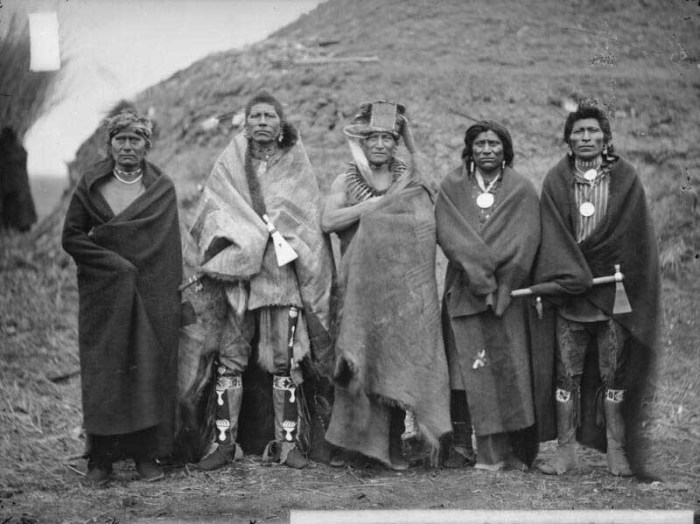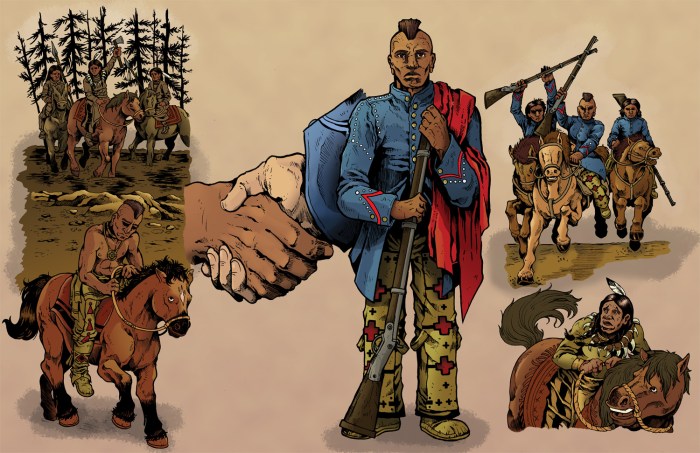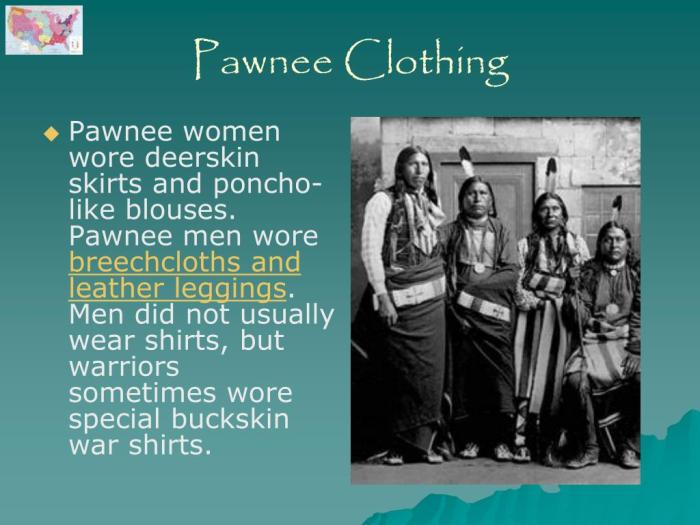What did the pawnee wear – Embark on a sartorial journey as we delve into the captivating world of Pawnee clothing. From ceremonial regalia to everyday attire, this exploration unravels the intricate artistry, cultural significance, and adaptive nature of Pawnee fashion.
Pawnee garments were not mere coverings but canvases upon which cultural identity, social status, and spiritual beliefs were woven.
Pawnee Clothing

The Pawnee tribe, an indigenous people of the Great Plains, had a distinct style of clothing that reflected their cultural values and environment.
Pawnee clothing was primarily made from animal skins, such as buffalo, deer, and antelope. These hides were tanned and softened using a traditional process involving animal brains and water. The clothing was then decorated with intricate beadwork, quillwork, and paint.
Clothing held great significance in Pawnee culture. It denoted an individual’s status, age, and gender. For example, women wore long dresses made from deerskin, while men wore breechcloths and leggings made from buffalo hide.
Pawnee Clothing: Materials and Construction
The Pawnee utilized various animal skins for their clothing, with buffalo hide being the most common. Buffalo hides provided durability and warmth, making them ideal for the harsh Great Plains climate. Deer and antelope skins were also used, particularly for clothing worn during warmer months.
The tanning process involved soaking the hides in a mixture of water and animal brains. This mixture helped to soften the hides and make them more pliable. Once tanned, the hides were stretched and dried to remove any excess moisture.
Pawnee Clothing: Significance
Pawnee clothing played a significant role in the tribe’s cultural identity and social structure. The type of clothing worn by an individual indicated their age, gender, and status within the community.
For instance, young children wore simple garments made from soft animal skins. As they grew older, they began to wear clothing that reflected their changing roles and responsibilities within the tribe.
Clothing also held spiritual significance for the Pawnee. Certain garments were worn during religious ceremonies and rituals, and they believed that the designs and decorations on their clothing possessed protective and symbolic powers.
Clothing for Different Occasions

Pawnee clothing varied depending on the occasion. For ceremonies, men wore elaborate headdresses made of eagle feathers, beaded shirts, and leggings. Women wore long dresses made of buckskin or cloth, often decorated with beads or quillwork. Children wore smaller versions of adult clothing.
During hunts, men wore simple clothing that allowed for freedom of movement. This included breechcloths, leggings, and moccasins. Women who accompanied hunting parties wore similar clothing, but they also carried packs to hold food and supplies.
For everyday activities, Pawnee people wore comfortable clothing made from buckskin or cloth. Men wore shirts, leggings, and moccasins. Women wore dresses or skirts and blouses. Children wore smaller versions of adult clothing.
Ornamentation and Accessories
Pawnee people used a variety of ornamentation and accessories to decorate their clothing. These included beads, quills, feathers, and paint. Beads were made from bone, shell, or glass. Quills were obtained from porcupines or birds. Feathers were collected from eagles, hawks, and other birds.
Paint was made from natural pigments.
Pawnee people used ornamentation and accessories to express their individuality and social status. For example, men who had killed an enemy in battle often wore eagle feathers in their hair. Women who were married wore their hair in a bun, while unmarried women wore their hair in braids.
Climate Adaptation and Clothing

The Pawnee lived on the Great Plains, which has a continental climate with hot summers and cold winters. Their clothing was adapted to these extreme temperatures.
Layers and Insulation
The Pawnee wore layers of clothing to trap air and insulate their bodies. The inner layer was usually made of soft, absorbent materials like deerskin or buffalo hide. The outer layer was made of tougher materials like elk hide or bear hide, which protected them from the wind and rain.
Weather-Resistant Materials
The Pawnee also used weather-resistant materials in their clothing. Buffalo hide was waterproof and windproof, making it ideal for winter clothing. Elk hide was more breathable and was often used for summer clothing.
Regulating Body Temperature
The Pawnee’s clothing helped them to regulate their body temperature. The layers of clothing trapped air and insulated their bodies, keeping them warm in the winter. In the summer, they could remove layers of clothing to cool down.
Symbolism and Meaning in Clothing

Clothing among the Pawnee tribe held deep symbolic meanings, reflecting their cultural identity, beliefs, and spiritual practices.
The Pawnee people of the Great Plains wore clothing made from animal skins and furs. Their garments were often decorated with beads and other adornments. Like ray bd bisects angle abc , the Pawnee’s clothing was designed to protect them from the elements and reflect their cultural identity.
They also wore moccasins and leggings made of soft leather.
Colors, Patterns, and Designs
Colors played a significant role in Pawnee clothing. Red symbolized war and strength, while blue represented peace and tranquility. Yellow and green were associated with the sun and nature, respectively. Patterns and designs often depicted animals, plants, and geometric shapes, each carrying specific meanings related to the wearer’s clan, status, or spiritual beliefs.
Influence of External Factors
Pawnee clothing evolved significantly over time due to the influence of neighboring tribes and European traders. Contact with other tribes, such as the Sioux and Cheyenne, led to the adoption of new styles and materials, such as the use of buffalo hide and porcupine quills.
European traders introduced cloth, metal ornaments, and glass beads, which were incorporated into traditional Pawnee garments.
Assimilation and Modernization, What did the pawnee wear
In the late 19th century, the Pawnee were forced to assimilate into American society. This led to a decline in the use of traditional clothing, as Pawnee people adopted Western-style clothing. However, some traditional elements, such as beadwork and quillwork, continued to be used in contemporary Pawnee clothing.
Today, traditional Pawnee clothing is primarily worn for ceremonial occasions and cultural events.
FAQ Explained: What Did The Pawnee Wear
What materials were commonly used in Pawnee clothing?
Pawnee clothing was primarily crafted from animal hides, such as buffalo, deer, and elk. These hides were tanned and softened using traditional techniques.
How did Pawnee clothing adapt to the Great Plains climate?
Pawnee clothing was designed to withstand the harsh conditions of the Great Plains. Garments featured multiple layers, insulation, and weather-resistant materials to regulate body temperature.
What role did ornamentation play in Pawnee clothing?
Ornamentation was an integral part of Pawnee clothing, serving both decorative and symbolic purposes. Beadwork, quillwork, and painted designs conveyed cultural identity, personal status, and spiritual beliefs.